Analyzing Principle of Care & Good Practice in Social Care Sector
VerifiedAdded on 2023/06/15
|9
|2644
|346
Report
AI Summary
This report explores the principles of care and good practice within the health and social care sectors. It discusses the implementation of these principles, referencing legislations, policies, and codes of conduct relevant to healthcare practices. The report emphasizes the importance of patient rights, autonomy, and safeguarding measures, balancing these against the need to protect vulnerable individuals. It highlights key concepts such as patient privacy, independence, equality, and confidentiality. Theories like Maslow's hierarchy of needs are examined for their practical application in patient care. The document also covers anti-discriminatory practices and the Equality Act 2010, ensuring fair treatment for both patients and care providers. The conclusion reinforces the central role of values and respect in delivering quality care, advocating for patient empowerment and the right to complain about inadequate services. Desklib provides solved assignments and past papers for students.
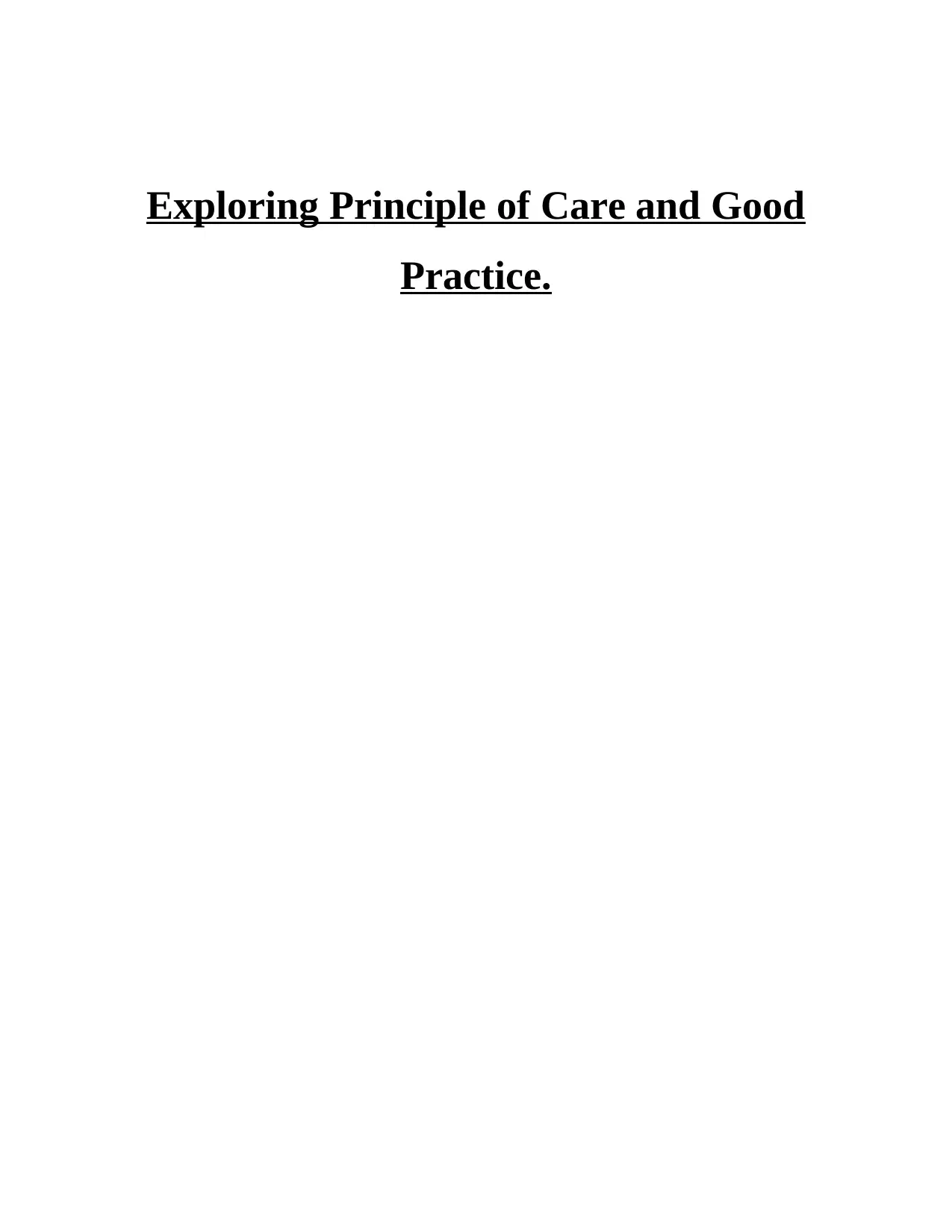
Exploring Principle of Care and Good
Practice.
Practice.
Secure Best Marks with AI Grader
Need help grading? Try our AI Grader for instant feedback on your assignments.

Table of Contents
INTRODUCTION...........................................................................................................................3
MAIN BODY...................................................................................................................................3
CONCLUSION................................................................................................................................8
REFERENCES................................................................................................................................9
INTRODUCTION...........................................................................................................................3
MAIN BODY...................................................................................................................................3
CONCLUSION................................................................................................................................8
REFERENCES................................................................................................................................9
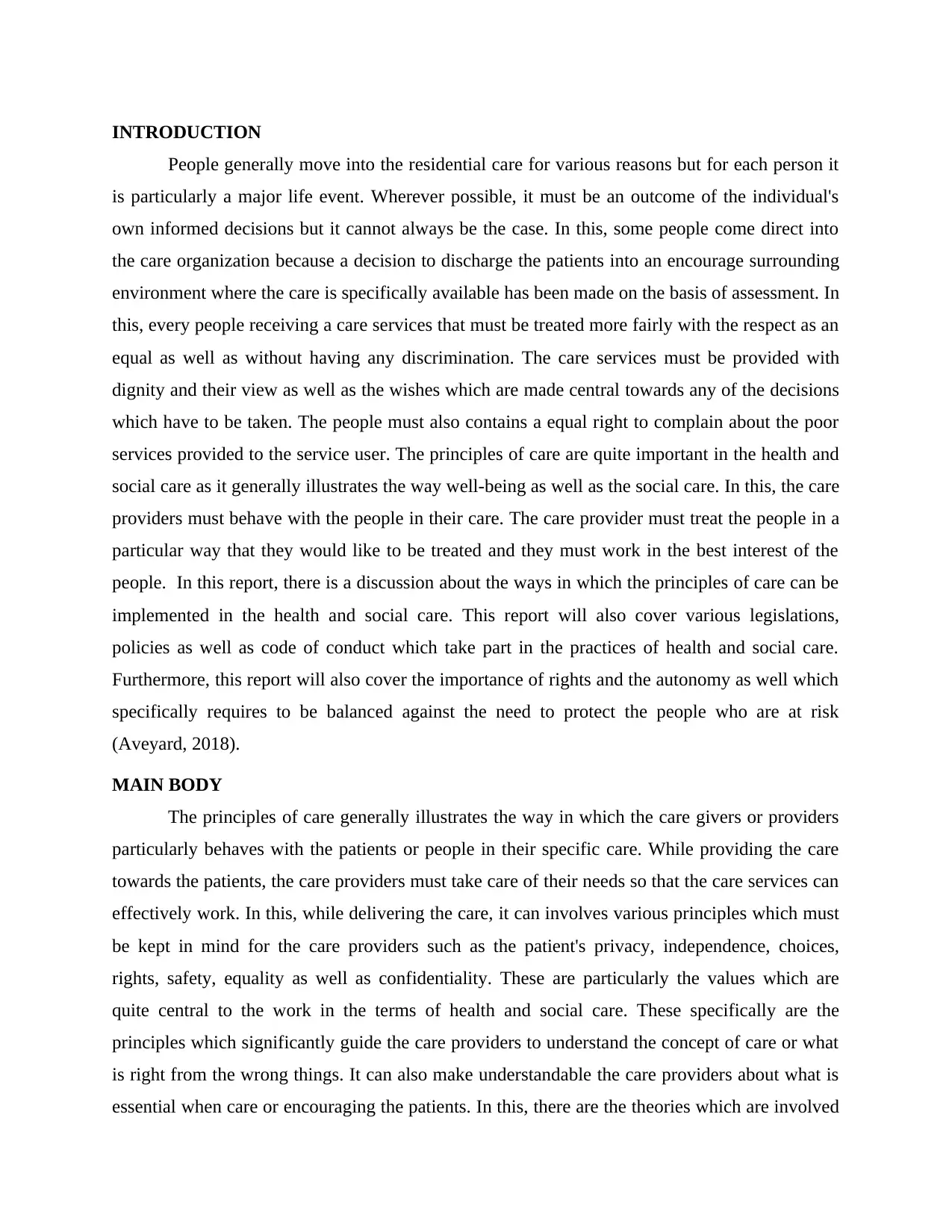
INTRODUCTION
People generally move into the residential care for various reasons but for each person it
is particularly a major life event. Wherever possible, it must be an outcome of the individual's
own informed decisions but it cannot always be the case. In this, some people come direct into
the care organization because a decision to discharge the patients into an encourage surrounding
environment where the care is specifically available has been made on the basis of assessment. In
this, every people receiving a care services that must be treated more fairly with the respect as an
equal as well as without having any discrimination. The care services must be provided with
dignity and their view as well as the wishes which are made central towards any of the decisions
which have to be taken. The people must also contains a equal right to complain about the poor
services provided to the service user. The principles of care are quite important in the health and
social care as it generally illustrates the way well-being as well as the social care. In this, the care
providers must behave with the people in their care. The care provider must treat the people in a
particular way that they would like to be treated and they must work in the best interest of the
people. In this report, there is a discussion about the ways in which the principles of care can be
implemented in the health and social care. This report will also cover various legislations,
policies as well as code of conduct which take part in the practices of health and social care.
Furthermore, this report will also cover the importance of rights and the autonomy as well which
specifically requires to be balanced against the need to protect the people who are at risk
(Aveyard, 2018).
MAIN BODY
The principles of care generally illustrates the way in which the care givers or providers
particularly behaves with the patients or people in their specific care. While providing the care
towards the patients, the care providers must take care of their needs so that the care services can
effectively work. In this, while delivering the care, it can involves various principles which must
be kept in mind for the care providers such as the patient's privacy, independence, choices,
rights, safety, equality as well as confidentiality. These are particularly the values which are
quite central to the work in the terms of health and social care. These specifically are the
principles which significantly guide the care providers to understand the concept of care or what
is right from the wrong things. It can also make understandable the care providers about what is
essential when care or encouraging the patients. In this, there are the theories which are involved
People generally move into the residential care for various reasons but for each person it
is particularly a major life event. Wherever possible, it must be an outcome of the individual's
own informed decisions but it cannot always be the case. In this, some people come direct into
the care organization because a decision to discharge the patients into an encourage surrounding
environment where the care is specifically available has been made on the basis of assessment. In
this, every people receiving a care services that must be treated more fairly with the respect as an
equal as well as without having any discrimination. The care services must be provided with
dignity and their view as well as the wishes which are made central towards any of the decisions
which have to be taken. The people must also contains a equal right to complain about the poor
services provided to the service user. The principles of care are quite important in the health and
social care as it generally illustrates the way well-being as well as the social care. In this, the care
providers must behave with the people in their care. The care provider must treat the people in a
particular way that they would like to be treated and they must work in the best interest of the
people. In this report, there is a discussion about the ways in which the principles of care can be
implemented in the health and social care. This report will also cover various legislations,
policies as well as code of conduct which take part in the practices of health and social care.
Furthermore, this report will also cover the importance of rights and the autonomy as well which
specifically requires to be balanced against the need to protect the people who are at risk
(Aveyard, 2018).
MAIN BODY
The principles of care generally illustrates the way in which the care givers or providers
particularly behaves with the patients or people in their specific care. While providing the care
towards the patients, the care providers must take care of their needs so that the care services can
effectively work. In this, while delivering the care, it can involves various principles which must
be kept in mind for the care providers such as the patient's privacy, independence, choices,
rights, safety, equality as well as confidentiality. These are particularly the values which are
quite central to the work in the terms of health and social care. These specifically are the
principles which significantly guide the care providers to understand the concept of care or what
is right from the wrong things. It can also make understandable the care providers about what is
essential when care or encouraging the patients. In this, there are the theories which are involved
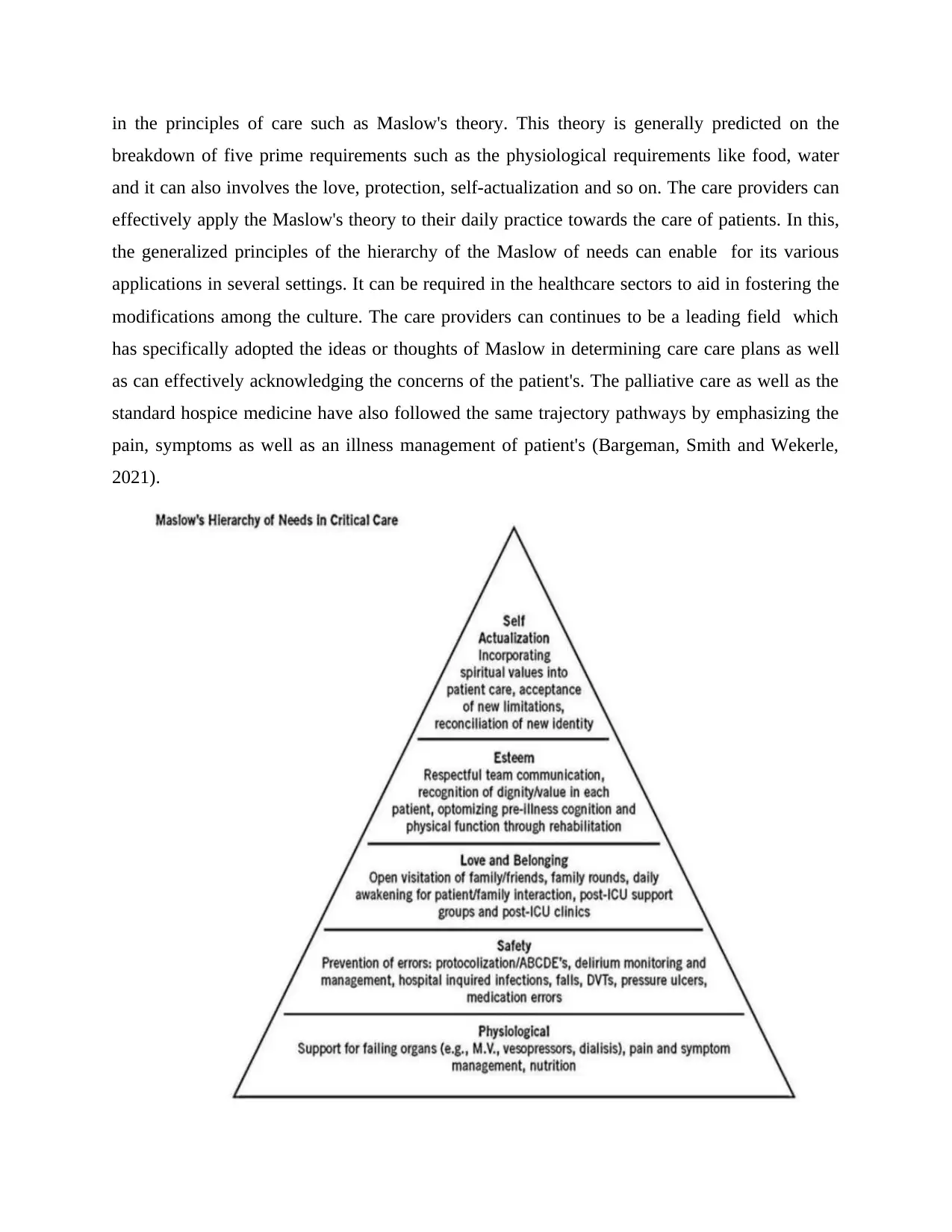
in the principles of care such as Maslow's theory. This theory is generally predicted on the
breakdown of five prime requirements such as the physiological requirements like food, water
and it can also involves the love, protection, self-actualization and so on. The care providers can
effectively apply the Maslow's theory to their daily practice towards the care of patients. In this,
the generalized principles of the hierarchy of the Maslow of needs can enable for its various
applications in several settings. It can be required in the healthcare sectors to aid in fostering the
modifications among the culture. The care providers can continues to be a leading field which
has specifically adopted the ideas or thoughts of Maslow in determining care care plans as well
as can effectively acknowledging the concerns of the patient's. The palliative care as well as the
standard hospice medicine have also followed the same trajectory pathways by emphasizing the
pain, symptoms as well as an illness management of patient's (Bargeman, Smith and Wekerle,
2021).
breakdown of five prime requirements such as the physiological requirements like food, water
and it can also involves the love, protection, self-actualization and so on. The care providers can
effectively apply the Maslow's theory to their daily practice towards the care of patients. In this,
the generalized principles of the hierarchy of the Maslow of needs can enable for its various
applications in several settings. It can be required in the healthcare sectors to aid in fostering the
modifications among the culture. The care providers can continues to be a leading field which
has specifically adopted the ideas or thoughts of Maslow in determining care care plans as well
as can effectively acknowledging the concerns of the patient's. The palliative care as well as the
standard hospice medicine have also followed the same trajectory pathways by emphasizing the
pain, symptoms as well as an illness management of patient's (Bargeman, Smith and Wekerle,
2021).
Secure Best Marks with AI Grader
Need help grading? Try our AI Grader for instant feedback on your assignments.
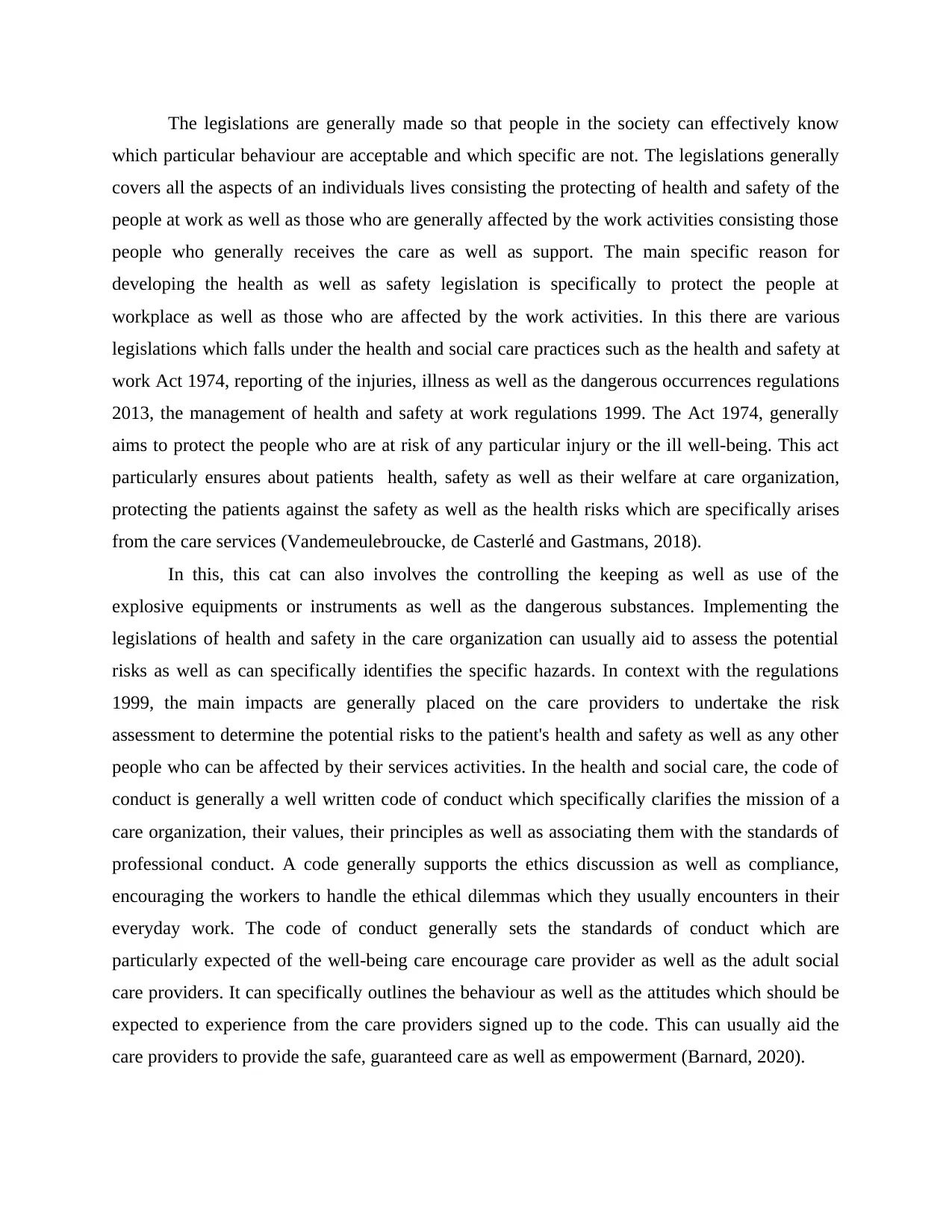
The legislations are generally made so that people in the society can effectively know
which particular behaviour are acceptable and which specific are not. The legislations generally
covers all the aspects of an individuals lives consisting the protecting of health and safety of the
people at work as well as those who are generally affected by the work activities consisting those
people who generally receives the care as well as support. The main specific reason for
developing the health as well as safety legislation is specifically to protect the people at
workplace as well as those who are affected by the work activities. In this there are various
legislations which falls under the health and social care practices such as the health and safety at
work Act 1974, reporting of the injuries, illness as well as the dangerous occurrences regulations
2013, the management of health and safety at work regulations 1999. The Act 1974, generally
aims to protect the people who are at risk of any particular injury or the ill well-being. This act
particularly ensures about patients health, safety as well as their welfare at care organization,
protecting the patients against the safety as well as the health risks which are specifically arises
from the care services (Vandemeulebroucke, de Casterlé and Gastmans, 2018).
In this, this cat can also involves the controlling the keeping as well as use of the
explosive equipments or instruments as well as the dangerous substances. Implementing the
legislations of health and safety in the care organization can usually aid to assess the potential
risks as well as can specifically identifies the specific hazards. In context with the regulations
1999, the main impacts are generally placed on the care providers to undertake the risk
assessment to determine the potential risks to the patient's health and safety as well as any other
people who can be affected by their services activities. In the health and social care, the code of
conduct is generally a well written code of conduct which specifically clarifies the mission of a
care organization, their values, their principles as well as associating them with the standards of
professional conduct. A code generally supports the ethics discussion as well as compliance,
encouraging the workers to handle the ethical dilemmas which they usually encounters in their
everyday work. The code of conduct generally sets the standards of conduct which are
particularly expected of the well-being care encourage care provider as well as the adult social
care providers. It can specifically outlines the behaviour as well as the attitudes which should be
expected to experience from the care providers signed up to the code. This can usually aid the
care providers to provide the safe, guaranteed care as well as empowerment (Barnard, 2020).
which particular behaviour are acceptable and which specific are not. The legislations generally
covers all the aspects of an individuals lives consisting the protecting of health and safety of the
people at work as well as those who are generally affected by the work activities consisting those
people who generally receives the care as well as support. The main specific reason for
developing the health as well as safety legislation is specifically to protect the people at
workplace as well as those who are affected by the work activities. In this there are various
legislations which falls under the health and social care practices such as the health and safety at
work Act 1974, reporting of the injuries, illness as well as the dangerous occurrences regulations
2013, the management of health and safety at work regulations 1999. The Act 1974, generally
aims to protect the people who are at risk of any particular injury or the ill well-being. This act
particularly ensures about patients health, safety as well as their welfare at care organization,
protecting the patients against the safety as well as the health risks which are specifically arises
from the care services (Vandemeulebroucke, de Casterlé and Gastmans, 2018).
In this, this cat can also involves the controlling the keeping as well as use of the
explosive equipments or instruments as well as the dangerous substances. Implementing the
legislations of health and safety in the care organization can usually aid to assess the potential
risks as well as can specifically identifies the specific hazards. In context with the regulations
1999, the main impacts are generally placed on the care providers to undertake the risk
assessment to determine the potential risks to the patient's health and safety as well as any other
people who can be affected by their services activities. In the health and social care, the code of
conduct is generally a well written code of conduct which specifically clarifies the mission of a
care organization, their values, their principles as well as associating them with the standards of
professional conduct. A code generally supports the ethics discussion as well as compliance,
encouraging the workers to handle the ethical dilemmas which they usually encounters in their
everyday work. The code of conduct generally sets the standards of conduct which are
particularly expected of the well-being care encourage care provider as well as the adult social
care providers. It can specifically outlines the behaviour as well as the attitudes which should be
expected to experience from the care providers signed up to the code. This can usually aid the
care providers to provide the safe, guaranteed care as well as empowerment (Barnard, 2020).
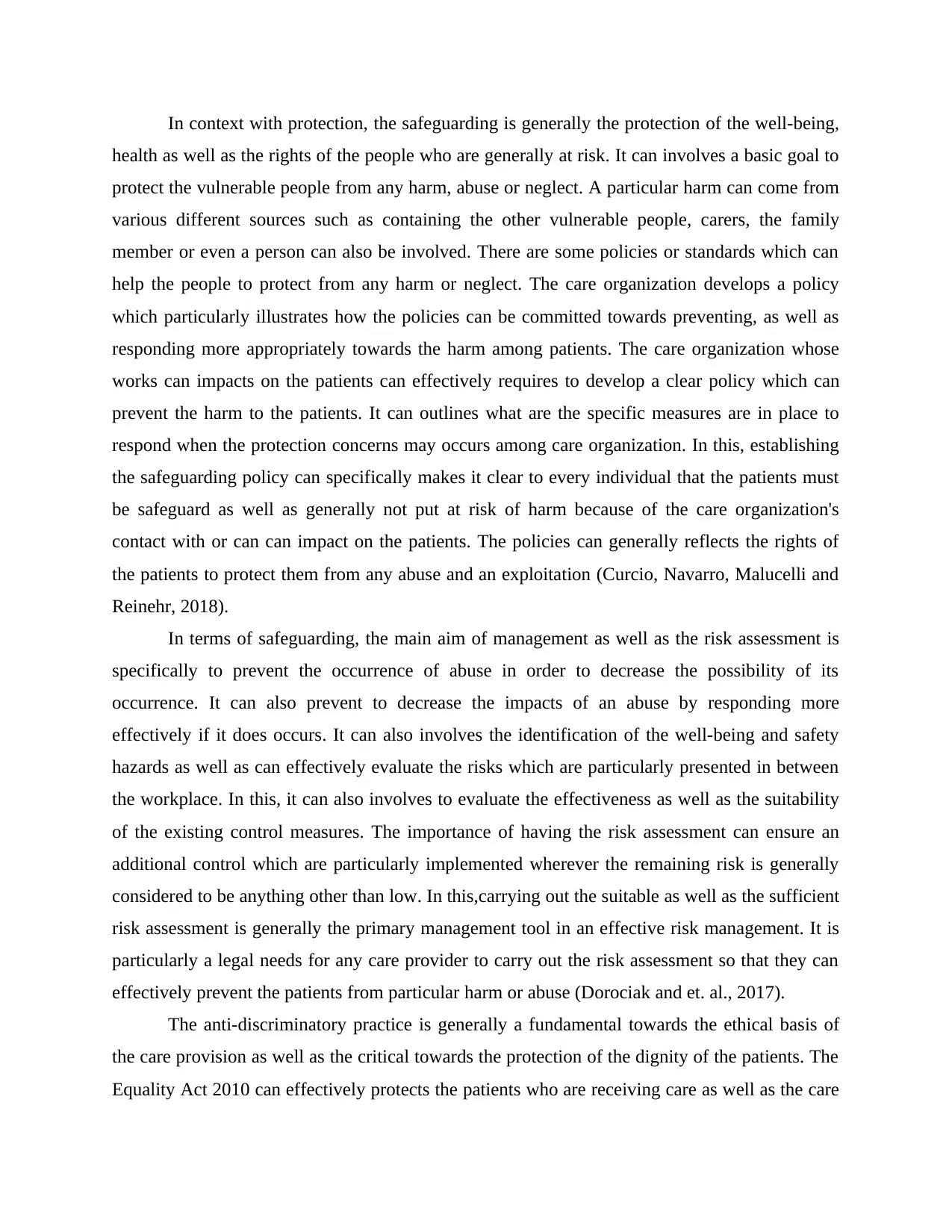
In context with protection, the safeguarding is generally the protection of the well-being,
health as well as the rights of the people who are generally at risk. It can involves a basic goal to
protect the vulnerable people from any harm, abuse or neglect. A particular harm can come from
various different sources such as containing the other vulnerable people, carers, the family
member or even a person can also be involved. There are some policies or standards which can
help the people to protect from any harm or neglect. The care organization develops a policy
which particularly illustrates how the policies can be committed towards preventing, as well as
responding more appropriately towards the harm among patients. The care organization whose
works can impacts on the patients can effectively requires to develop a clear policy which can
prevent the harm to the patients. It can outlines what are the specific measures are in place to
respond when the protection concerns may occurs among care organization. In this, establishing
the safeguarding policy can specifically makes it clear to every individual that the patients must
be safeguard as well as generally not put at risk of harm because of the care organization's
contact with or can can impact on the patients. The policies can generally reflects the rights of
the patients to protect them from any abuse and an exploitation (Curcio, Navarro, Malucelli and
Reinehr, 2018).
In terms of safeguarding, the main aim of management as well as the risk assessment is
specifically to prevent the occurrence of abuse in order to decrease the possibility of its
occurrence. It can also prevent to decrease the impacts of an abuse by responding more
effectively if it does occurs. It can also involves the identification of the well-being and safety
hazards as well as can effectively evaluate the risks which are particularly presented in between
the workplace. In this, it can also involves to evaluate the effectiveness as well as the suitability
of the existing control measures. The importance of having the risk assessment can ensure an
additional control which are particularly implemented wherever the remaining risk is generally
considered to be anything other than low. In this,carrying out the suitable as well as the sufficient
risk assessment is generally the primary management tool in an effective risk management. It is
particularly a legal needs for any care provider to carry out the risk assessment so that they can
effectively prevent the patients from particular harm or abuse (Dorociak and et. al., 2017).
The anti-discriminatory practice is generally a fundamental towards the ethical basis of
the care provision as well as the critical towards the protection of the dignity of the patients. The
Equality Act 2010 can effectively protects the patients who are receiving care as well as the care
health as well as the rights of the people who are generally at risk. It can involves a basic goal to
protect the vulnerable people from any harm, abuse or neglect. A particular harm can come from
various different sources such as containing the other vulnerable people, carers, the family
member or even a person can also be involved. There are some policies or standards which can
help the people to protect from any harm or neglect. The care organization develops a policy
which particularly illustrates how the policies can be committed towards preventing, as well as
responding more appropriately towards the harm among patients. The care organization whose
works can impacts on the patients can effectively requires to develop a clear policy which can
prevent the harm to the patients. It can outlines what are the specific measures are in place to
respond when the protection concerns may occurs among care organization. In this, establishing
the safeguarding policy can specifically makes it clear to every individual that the patients must
be safeguard as well as generally not put at risk of harm because of the care organization's
contact with or can can impact on the patients. The policies can generally reflects the rights of
the patients to protect them from any abuse and an exploitation (Curcio, Navarro, Malucelli and
Reinehr, 2018).
In terms of safeguarding, the main aim of management as well as the risk assessment is
specifically to prevent the occurrence of abuse in order to decrease the possibility of its
occurrence. It can also prevent to decrease the impacts of an abuse by responding more
effectively if it does occurs. It can also involves the identification of the well-being and safety
hazards as well as can effectively evaluate the risks which are particularly presented in between
the workplace. In this, it can also involves to evaluate the effectiveness as well as the suitability
of the existing control measures. The importance of having the risk assessment can ensure an
additional control which are particularly implemented wherever the remaining risk is generally
considered to be anything other than low. In this,carrying out the suitable as well as the sufficient
risk assessment is generally the primary management tool in an effective risk management. It is
particularly a legal needs for any care provider to carry out the risk assessment so that they can
effectively prevent the patients from particular harm or abuse (Dorociak and et. al., 2017).
The anti-discriminatory practice is generally a fundamental towards the ethical basis of
the care provision as well as the critical towards the protection of the dignity of the patients. The
Equality Act 2010 can effectively protects the patients who are receiving care as well as the care

providers which provides the care from being being treated unfairly. This is particularly because
of any particular characteristics (age, disability and many more) which are specifically protected
under the policies or legislations. In this, the direct discrimination can generally occurs when
someone is treated less favourably then someone else in the very same circumstances on the
grounds of a protected characteristics. In the indirect discrimination can particularly occurs when
a condition or the needs are generally applied equally over every people, but some are unable to
follow because of a protected characteristics.
of any particular characteristics (age, disability and many more) which are specifically protected
under the policies or legislations. In this, the direct discrimination can generally occurs when
someone is treated less favourably then someone else in the very same circumstances on the
grounds of a protected characteristics. In the indirect discrimination can particularly occurs when
a condition or the needs are generally applied equally over every people, but some are unable to
follow because of a protected characteristics.
Paraphrase This Document
Need a fresh take? Get an instant paraphrase of this document with our AI Paraphraser
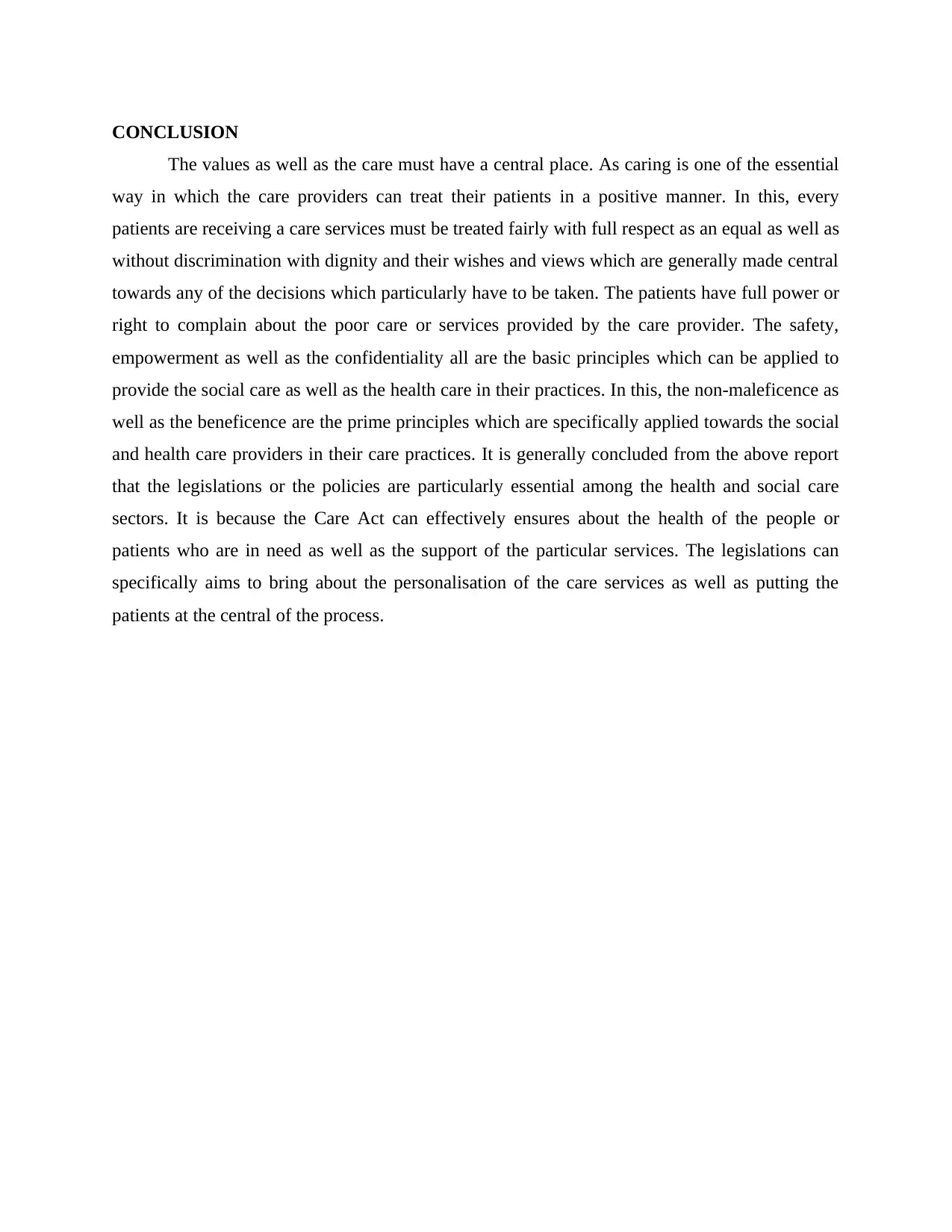
CONCLUSION
The values as well as the care must have a central place. As caring is one of the essential
way in which the care providers can treat their patients in a positive manner. In this, every
patients are receiving a care services must be treated fairly with full respect as an equal as well as
without discrimination with dignity and their wishes and views which are generally made central
towards any of the decisions which particularly have to be taken. The patients have full power or
right to complain about the poor care or services provided by the care provider. The safety,
empowerment as well as the confidentiality all are the basic principles which can be applied to
provide the social care as well as the health care in their practices. In this, the non-maleficence as
well as the beneficence are the prime principles which are specifically applied towards the social
and health care providers in their care practices. It is generally concluded from the above report
that the legislations or the policies are particularly essential among the health and social care
sectors. It is because the Care Act can effectively ensures about the health of the people or
patients who are in need as well as the support of the particular services. The legislations can
specifically aims to bring about the personalisation of the care services as well as putting the
patients at the central of the process.
The values as well as the care must have a central place. As caring is one of the essential
way in which the care providers can treat their patients in a positive manner. In this, every
patients are receiving a care services must be treated fairly with full respect as an equal as well as
without discrimination with dignity and their wishes and views which are generally made central
towards any of the decisions which particularly have to be taken. The patients have full power or
right to complain about the poor care or services provided by the care provider. The safety,
empowerment as well as the confidentiality all are the basic principles which can be applied to
provide the social care as well as the health care in their practices. In this, the non-maleficence as
well as the beneficence are the prime principles which are specifically applied towards the social
and health care providers in their care practices. It is generally concluded from the above report
that the legislations or the policies are particularly essential among the health and social care
sectors. It is because the Care Act can effectively ensures about the health of the people or
patients who are in need as well as the support of the particular services. The legislations can
specifically aims to bring about the personalisation of the care services as well as putting the
patients at the central of the process.
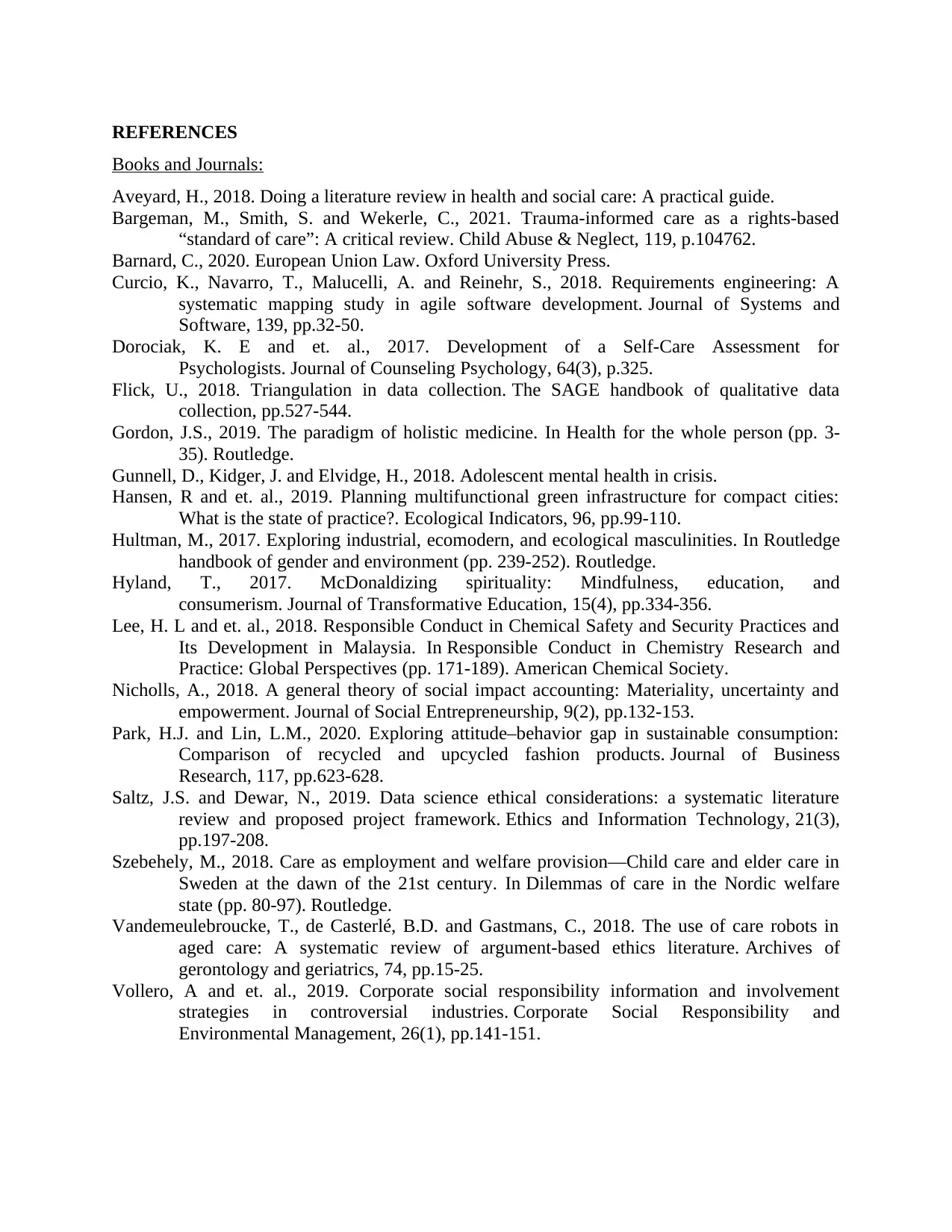
REFERENCES
Books and Journals:
Aveyard, H., 2018. Doing a literature review in health and social care: A practical guide.
Bargeman, M., Smith, S. and Wekerle, C., 2021. Trauma-informed care as a rights-based
“standard of care”: A critical review. Child Abuse & Neglect, 119, p.104762.
Barnard, C., 2020. European Union Law. Oxford University Press.
Curcio, K., Navarro, T., Malucelli, A. and Reinehr, S., 2018. Requirements engineering: A
systematic mapping study in agile software development. Journal of Systems and
Software, 139, pp.32-50.
Dorociak, K. E and et. al., 2017. Development of a Self-Care Assessment for
Psychologists. Journal of Counseling Psychology, 64(3), p.325.
Flick, U., 2018. Triangulation in data collection. The SAGE handbook of qualitative data
collection, pp.527-544.
Gordon, J.S., 2019. The paradigm of holistic medicine. In Health for the whole person (pp. 3-
35). Routledge.
Gunnell, D., Kidger, J. and Elvidge, H., 2018. Adolescent mental health in crisis.
Hansen, R and et. al., 2019. Planning multifunctional green infrastructure for compact cities:
What is the state of practice?. Ecological Indicators, 96, pp.99-110.
Hultman, M., 2017. Exploring industrial, ecomodern, and ecological masculinities. In Routledge
handbook of gender and environment (pp. 239-252). Routledge.
Hyland, T., 2017. McDonaldizing spirituality: Mindfulness, education, and
consumerism. Journal of Transformative Education, 15(4), pp.334-356.
Lee, H. L and et. al., 2018. Responsible Conduct in Chemical Safety and Security Practices and
Its Development in Malaysia. In Responsible Conduct in Chemistry Research and
Practice: Global Perspectives (pp. 171-189). American Chemical Society.
Nicholls, A., 2018. A general theory of social impact accounting: Materiality, uncertainty and
empowerment. Journal of Social Entrepreneurship, 9(2), pp.132-153.
Park, H.J. and Lin, L.M., 2020. Exploring attitude–behavior gap in sustainable consumption:
Comparison of recycled and upcycled fashion products. Journal of Business
Research, 117, pp.623-628.
Saltz, J.S. and Dewar, N., 2019. Data science ethical considerations: a systematic literature
review and proposed project framework. Ethics and Information Technology, 21(3),
pp.197-208.
Szebehely, M., 2018. Care as employment and welfare provision—Child care and elder care in
Sweden at the dawn of the 21st century. In Dilemmas of care in the Nordic welfare
state (pp. 80-97). Routledge.
Vandemeulebroucke, T., de Casterlé, B.D. and Gastmans, C., 2018. The use of care robots in
aged care: A systematic review of argument-based ethics literature. Archives of
gerontology and geriatrics, 74, pp.15-25.
Vollero, A and et. al., 2019. Corporate social responsibility information and involvement
strategies in controversial industries. Corporate Social Responsibility and
Environmental Management, 26(1), pp.141-151.
Books and Journals:
Aveyard, H., 2018. Doing a literature review in health and social care: A practical guide.
Bargeman, M., Smith, S. and Wekerle, C., 2021. Trauma-informed care as a rights-based
“standard of care”: A critical review. Child Abuse & Neglect, 119, p.104762.
Barnard, C., 2020. European Union Law. Oxford University Press.
Curcio, K., Navarro, T., Malucelli, A. and Reinehr, S., 2018. Requirements engineering: A
systematic mapping study in agile software development. Journal of Systems and
Software, 139, pp.32-50.
Dorociak, K. E and et. al., 2017. Development of a Self-Care Assessment for
Psychologists. Journal of Counseling Psychology, 64(3), p.325.
Flick, U., 2018. Triangulation in data collection. The SAGE handbook of qualitative data
collection, pp.527-544.
Gordon, J.S., 2019. The paradigm of holistic medicine. In Health for the whole person (pp. 3-
35). Routledge.
Gunnell, D., Kidger, J. and Elvidge, H., 2018. Adolescent mental health in crisis.
Hansen, R and et. al., 2019. Planning multifunctional green infrastructure for compact cities:
What is the state of practice?. Ecological Indicators, 96, pp.99-110.
Hultman, M., 2017. Exploring industrial, ecomodern, and ecological masculinities. In Routledge
handbook of gender and environment (pp. 239-252). Routledge.
Hyland, T., 2017. McDonaldizing spirituality: Mindfulness, education, and
consumerism. Journal of Transformative Education, 15(4), pp.334-356.
Lee, H. L and et. al., 2018. Responsible Conduct in Chemical Safety and Security Practices and
Its Development in Malaysia. In Responsible Conduct in Chemistry Research and
Practice: Global Perspectives (pp. 171-189). American Chemical Society.
Nicholls, A., 2018. A general theory of social impact accounting: Materiality, uncertainty and
empowerment. Journal of Social Entrepreneurship, 9(2), pp.132-153.
Park, H.J. and Lin, L.M., 2020. Exploring attitude–behavior gap in sustainable consumption:
Comparison of recycled and upcycled fashion products. Journal of Business
Research, 117, pp.623-628.
Saltz, J.S. and Dewar, N., 2019. Data science ethical considerations: a systematic literature
review and proposed project framework. Ethics and Information Technology, 21(3),
pp.197-208.
Szebehely, M., 2018. Care as employment and welfare provision—Child care and elder care in
Sweden at the dawn of the 21st century. In Dilemmas of care in the Nordic welfare
state (pp. 80-97). Routledge.
Vandemeulebroucke, T., de Casterlé, B.D. and Gastmans, C., 2018. The use of care robots in
aged care: A systematic review of argument-based ethics literature. Archives of
gerontology and geriatrics, 74, pp.15-25.
Vollero, A and et. al., 2019. Corporate social responsibility information and involvement
strategies in controversial industries. Corporate Social Responsibility and
Environmental Management, 26(1), pp.141-151.
1 out of 9
Related Documents
Your All-in-One AI-Powered Toolkit for Academic Success.
+13062052269
info@desklib.com
Available 24*7 on WhatsApp / Email
![[object Object]](/_next/static/media/star-bottom.7253800d.svg)
Unlock your academic potential
© 2024 | Zucol Services PVT LTD | All rights reserved.



